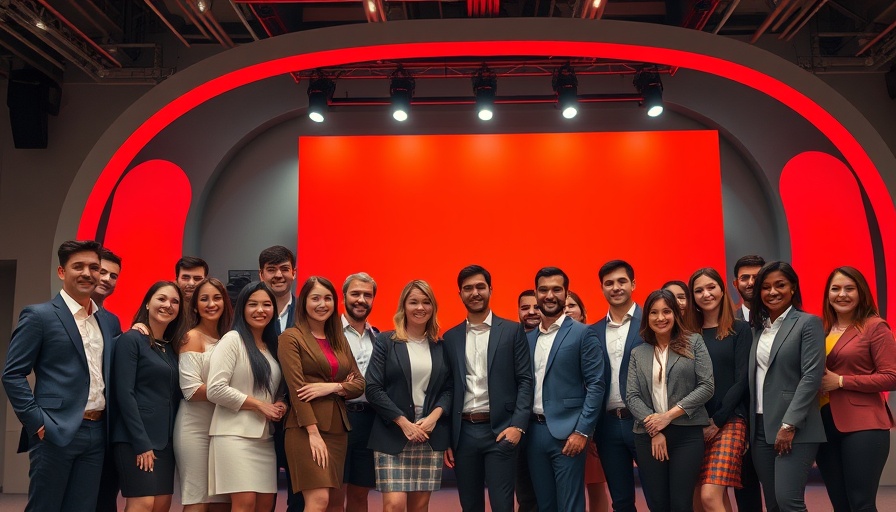
The Rise of Visionary Startups in 2025
As we dive into the world of innovation and technology, the finalists of VivaTech 2025 stand out not only as leaders in their fields but also as examples of how startups continue to play a vital role in addressing pressing global challenges. This year’s selection for the Innovation of the Year award showcases a compelling range of ideas that push the boundaries of technology, proving that imagination coupled with technical prowess can yield groundbreaking solutions.
What Makes These Finalists Stand Out?
Narrowing down the immense talent pool of 30 visionary startups to just five finalists was no small task. Each contender demonstrated remarkable creativity, solidified its standing through rigorous evaluations, and submitted solutions that can transform industries. Let's meet the top five.
BeyondMath: Revolutionizing Physics Simulations
BeyondMath is making waves in the engineering field with its generative physics platform. Traditionally, engineers have faced slow and costly simulations. With BeyondMath, it’s a different story; they can now conduct simulations at a staggering 1000 times faster. This advancement not only minimizes time and costs but also enables engineers to explore significantly more design options rapidly. It’s a groundbreaking shift that makes innovation more accessible.
Chipiron: Making MRI Scans Accessible
Another finalist, Chipiron, is on a mission to democratize healthcare imaging with the world's first light and low-cost MRI technology. By utilizing ultra-low magnetic fields, their system retains high image quality while dramatically lowering the cost of MRI scans. This innovation could lead to early screenings on a massive scale, likening access to an MRI test to a simple blood test—providing hope for early diagnosis and treatment for countless individuals.
Enerdrape: Harnessing Geothermal Energy
Enerdrape is an ambitious startup with its sights set on sustainability. By offering non-invasive geothermal panels, they transform urban underground spaces into sources of renewable energy. Imagine car parks or tunnels contributing to heating and cooling solutions without conventional drilling methods. This innovative approach can significantly reduce carbon footprints, lowering costs while promoting environmental conservation in densely populated areas.
Hua Tech International: A Step Forward in Cancer Diagnostics
In the realm of cancer diagnostics, Hua Tech International is leading the charge with its automated microfluidic platform. This cutting-edge technology integrates a biochip capable of identifying rare circulating cancer cells with precision. This innovation could revolutionize how we detect cancer, enabling earlier diagnosis and potentially saving more lives.
Lumisync: Speeding Up Data Processing
The last finalist, Lumisync, is enhancing the efficiency of data centers worldwide with its 100% photonic oscillator. This technology allows data to flow at the speed of light, drastically cutting latency and energy consumption by over 1000 times. In a world increasingly reliant on data, such developments will not only improve performance but also contribute to sustainability within the tech industry!
Looking Toward the Future of Technology
The finalists at VivaTech 2025 exemplify how creativity paired with technological advancement can lead to solutions addressing some of the world's most pressing challenges. From healthcare to energy consumption, these startups are set to make significant impacts, pushing us closer to a better and more sustainable future.
What This Means for Emerging Startups
For upcoming entrepreneurs and innovators, this spotlight on visionary startups acts as a source of inspiration. Progressing through rigorous vetting processes to gain recognition can not only raise awareness for their ventures but also attract potential investors, partnerships, and opportunities. The success of these companies may indeed catalyze the next generation of innovators who view the landscape of technology and business not as boundaries but as an expansive field of opportunities.
The rise of these finalists also emphasizes the importance of technological news coverage, such as that provided by TechCrunch and other leading sources that keep us informed on the latest developments in the tech world. Being aware of trends and innovations is essential for stakeholders at all levels—from investors to consumers—to navigate the future effectively.
As we anticipate the competition's conclusion on June 11, 2025, be sure to stay updated on these fascinating advances in technology and what they could mean for our global landscape.
 Add Row
Add Row  Add
Add 



Write A Comment